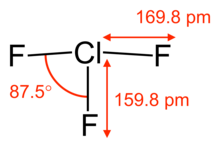Chlorine trifluoride
| Structural formula | ||||||||||||||||
|---|---|---|---|---|---|---|---|---|---|---|---|---|---|---|---|---|

|
||||||||||||||||
| General | ||||||||||||||||
| Surname | Chlorine trifluoride | |||||||||||||||
| other names |
Chlorine (III) fluoride |
|||||||||||||||
| Molecular formula | ClF 3 | |||||||||||||||
| Brief description |
colorless to light yellow gas with a sweet odor; yellow-green as liquid; colorless as a solid |
|||||||||||||||
| External identifiers / databases | ||||||||||||||||
|
||||||||||||||||
| properties | ||||||||||||||||
| Molar mass | 92.45 g mol −1 | |||||||||||||||
| Physical state |
gaseous |
|||||||||||||||
| density |
3.57 kg m −3 (gas density at 0 ° C) |
|||||||||||||||
| Melting point |
−76.31 ° C |
|||||||||||||||
| boiling point |
11.8 ° C |
|||||||||||||||
| Vapor pressure |
1.42 k Pa (20 ° C) |
|||||||||||||||
| solubility |
hydrolyzed in water |
|||||||||||||||
| safety instructions | ||||||||||||||||
|
||||||||||||||||
| MAK |
Switzerland: 0.1 ml m −3 or 0.4 mg m −3 |
|||||||||||||||
| As far as possible and customary, SI units are used. Unless otherwise noted, the data given apply to standard conditions . | ||||||||||||||||
Chlorine trifluoride is an interhalogen compound . It is a colorless, poisonous, pungent smelling, caustic gas that develops white mist in moist air. Like all interhalogen compounds, it is very reactive.
Extraction and presentation
Chlorine trifluoride can be produced from the elements chlorine and fluorine at 400 ° C.
properties
Chlorine trifluoride is a colorless to light yellow gas that turns into a liquid at approx. 12 ° C and solidifies at −76.3 ° C. In diluted form, the gas has a sweetish odor, and in higher concentrations it is strongly irritating. Chlorine trifluoride reacts explosively with water, releasing oxygen. Chemically, chlorine trifluoride behaves like a strong oxidizing agent ; it attacks metals by forming fluoride . The further reaction with metals depends on whether the fluoride layer formed is stable; this is the case with copper , so that it is manufactured in copper vessels. Non-metals do not form a protective layer, but are set on fire. Glass destroys it immediately, as does quartz in the presence of traces of moisture. Organic substances usually react with the appearance of fire.
Chlorine trifluoride also attacks the fillers of the respiratory protection filters ( activated carbon ).
use
Chlorine trifluoride can be used for fluorination . Due to its easier handling compared to fluorine, it is used as a fluorinating agent in uranium hexafluoride production. It is also used in the manufacture of microelectronics and sensors. Welding gases are added to increase the combustion temperature .
During the Second World War it was produced in Germany under the cover name "N-Stoff", although its use as a warfare agent or as an incendiary agent was considered. The high energy content of the compound and its boiling point suggest its use as a storable, high-energy oxidizer in rocket technology, but this application never got beyond the experimental stage due to handling problems.
toxicology
As an inhalation poison, it affects the entire respiratory tract. The consequences are bloating and swelling of the lungs, chemical burns of the upper respiratory tract and even purulent bronchitis . High concentrations lead to severe irritable coughs and severe lung damage. Gaseous chlorine (III) fluoride attacks the eyes very severely; the damage leads to corneal opacity.
See also
Individual evidence
- ↑ a b c d e f g Entry on chlorine trifluoride in the GESTIS substance database of the IFA , accessed on January 10, 2017(JavaScript required) .
- ↑ Swiss Accident Insurance Fund (Suva): Limit values - current MAK and BAT values (search for 7790-91-2 or chlorine trifluoride ), accessed on November 2, 2015.
- ↑ a b Georg Brauer (Ed.), With the collaboration of Marianne Baudler u a .: Handbook of Preparative Inorganic Chemistry. 3rd, revised edition. Volume I, Ferdinand Enke, Stuttgart 1975, ISBN 3-432-02328-6 , p. 168.
- ↑ a b entry on chlorofluoride. In: Römpp Online . Georg Thieme Verlag, accessed on May 26, 2014.
- ↑ Patent EP 1902456 A1 (on Google Patents)
- ↑ John D. Clark: Ignition! An Informal History of Liquid Rocket Propellants. Rutgers University Press, Piscataway, NJ, 1972, pp. 214ff.







